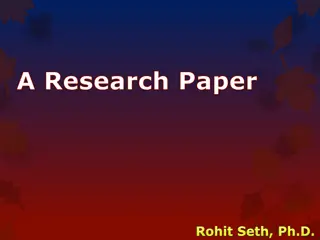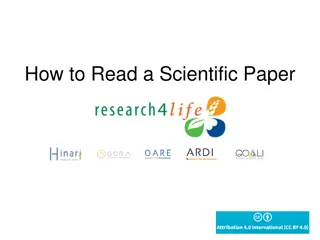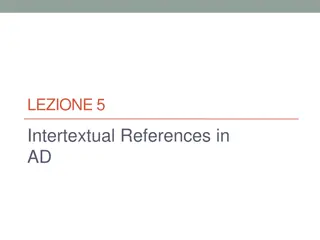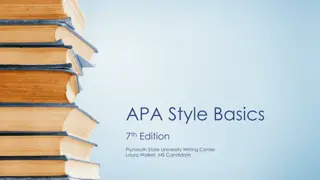Guide to Creating References in Theses and TDK papers
References are crucial in academic writing to acknowledge sources and avoid plagiarism. This guide covers why references are necessary, types of plagiarism, what can be referred to in a thesis, document types in literature, and efficient ways to search for literature sources in veterinary medicine.
Download Presentation

Please find below an Image/Link to download the presentation.
The content on the website is provided AS IS for your information and personal use only. It may not be sold, licensed, or shared on other websites without obtaining consent from the author.If you encounter any issues during the download, it is possible that the publisher has removed the file from their server.
You are allowed to download the files provided on this website for personal or commercial use, subject to the condition that they are used lawfully. All files are the property of their respective owners.
The content on the website is provided AS IS for your information and personal use only. It may not be sold, licensed, or shared on other websites without obtaining consent from the author.
E N D
Presentation Transcript
Guide to Creating References in Theses and TDK papers 2021 spring University of Veterinary Medicine Budapest Hut ra Ferenc Library, Archives and Museum 1078 Budapest, Istv n u. 2. Tel.: +36-1 478 4226 E-mail: library@univet.hu 1
What are the references? Why are they required? New scientific results are based on previous ones. They are used in the academic writing. The resource of the adopted ideas, statements, scientific results, data sheets, images etc. should be indicated. Naming the source is the reference. A short part of the original text can be cited word by word. This is the quotation. The quoted text has to be put within quotation marks. The exact page number is required in the reference from where the text is quoted. Missing reference is like if the author called someone else s work as his/her own. This is plagiarism, even if it is only an accident.
Plagiarism types Plagiarisms committed by students types and rates Source: Turnitin, 2018: The Plagiarism Spectrum. https://www.turnitin.com/infographics/the-plagiarism-spectrum Let ltve: 2018.10.04. Hut ra Ferenc Library, Archive & Museum, e-mail: library@univet.hu, http://library.univet.hu 3
What can be referred to in a thesis? Complete academic paper (publication) Literature Data, data collection in a data repository Patent Standard Papers of academic/professional boards Communications of policy makers, e.g.: Law, legislation Recommendation or directive of the European Union etc. If the content is not accessible in the literature, other types of published documents, too, may be referred to.
Document types in the literature Book Part of book (chapter, volume, essay etc.) Journal article Conference paper Thesis: habilitation lecture (published) doctoral, PhD, academy candidate thesis thesis. Literature found on the internet or in the library usually belongs to one of the above mentioned types of documents, whether they are online or in print.
Literature sources Literatures (papers) are most efficiently searched in secondary sources, mainly in literature databases. These can be accessed via the Library's website. Several databases, subscribed e-books and most of the articles found in the websites of subscription-base journals are available only for the subscribers. Such contents are accessible from a university IP address or via VPN.
How to create a reference? A resource has to be referred to twice in an academic paper: Literatures are listed at the end of the paper in the Bibliography or List of References in the form of bibliographic references. In the body of text, where the author adopts an idea, statement, data, etc. from the literature, he/she refers to the literature listed in the bibliography in the form of a brief in-text reference. The in-text reference is usually placed at the end of a sentence or paragraph.
Reference styles There are approx. 10,000 different reference styles in the academic communication. The main data sets of the references: author/s, title/s, data of publication can be found in all styles, but the order, format, data displayed and/or the typography is different to a greater or lesser extent in each style.
Reference style of theses at the UVMB The University of Veterinary Medicine Budapest expects a variant of the Springer Basic reference style for student theses and TDK theses. The same reference style is used by the journal Magyar llatorvosok Lapja from 2021. The creation of references and a bibliography can be automated by using a Reference Manager software.Available for free: Zotero Springer Basic (numeric, brackets no et al. ) style Mendeley Springer - Basic (numeric, brackets no et al. ) LaTex/BibTex templates are available at the Library website
Formatting of references in-text reference In-text reference is an arabic number within square brackets: [1] according to the the reference style used by the university. The number increases one by one from 1 as the author cites more and more literature. In the bibliography, the references are numbered with these numbers and are listed in order. If a literature has to be referred to more than once, it is not given a new number: it is referred to by the number of the first occurrence. E.g.: Blah blah blah. [9] Blah blah blah. [1] Several literatures can be referred to at one place of the body of text. In this case, the references should be listed in ascending numerical order in common brackets. E.g.: [1, 3, 4]
Formatting of references bibliographic reference The bibliographic reference should list data from the following data sets: author/s, title/s, data of publication Data of publication may contain different types of data depending on the type of document of the respective literature.
Data sets of the bibliographic reference: author/s Authors should be listed in the order they appear in the literature. All authors of the literature should be listed, up to 30 ones. The abbreviation et al. may be used instead of additional (30+) author names. The author names are in Hungarian order: the surname comes first. First names (given names) and middle names are replaced by their initials, without the abbreviation dot. If there are several first names, the space between the initials may be omitted. Each author name is separated by a comma. The last author name or et al. is followed by the year of publication in round brackets.
Data sets of the bibliographic reference: title/s The title and, if there is any, the subtitle/s should be entered after the year of publication. Each title should be followed by a colon and a space, or by a punctuation mark used in the literature, e.g.: The last title is separated from the data of publication by a period and a space.
Data sets of the bibliographic reference: data of publication The year of publication follows the last author name or et al. in round brackets. Papers, which are part of an enframing document, such as journal article, part of a book, conference papers should be described: 1. after the author/s names and title/s of the paper (part of a document) 2. come the author/s/editor/s names (where applicable) and title/s of the enframing document 3. followed by the data of publication of the enframing document (year of publication excluded) 4. finally, the start and end page numbers and/or the unique ID number of the part of the document.
Bibliographic reference of a book Title 1. There is/are author/s Authors Stanchi NO, Martino PE (2005) Microbiolog a veterinaria. Inter-M dica, BuenosAires Year of publication Place of publication Publisher 2. Neither author, nor editor Year of publication Title (2003) Compendium of pharmacy student/resident pharmacy practice/pharmacy education research projects in the year 2001. Canadian Society of Hospital Pharmacists, Ottawa, ON Publisher Place of publication
Bibliographic reference of a book Title 1. There is editor Editor/s Harvey CE, Newton CD, Schwartz A(eds) (1990) Small animal surgery. J. B. Lippincott, Philadelphia PA Place of publication Year of publication Publisher Subtitle 2. Only online edition Robbins L (2011) Distillation Control, Optimization, and Tuning: Fundamentals and Strategies : Fundamentals and Strategies. Taylor & Francis. https://library.oapen.org/handle/20.500.12657/40115 Publisher URL (permalink)
Bibliographic reference of a part (chapter) of a book Title of the chapter Title of the book Author of the chapter Hornok S (2017) Dermacentor marginatus (Sulzer, 1776) (Figs. 111 113). In: Estrada-Pe a A, Mihalca AD, Petney TN (eds) Ticks of Europe and North Africa: A Guide to Species Identification. Springer International Publishing, Cham, pp 281 285 Publisher Place of publication Start-end page numbers of the chapter Editor/s of the book Year of publication The data of the enframing document (book) is preceded by In:.
Bibliographic reference of a journal article Article title Year of publication Author/s of the article Caloni F, Cortinovis C, Rivolta M, Alonge S, Davanzo F (2013) Plant poisoning in domestic animals: epidemiological data from an Italian survey (2000-2011). https://doi.org/10.1136/vr.101225 Abbreviated journal title Vet Rec 172(22) 580 Volume number Issue number DOI number Page number (a1 page long article) The issue number is not necessary for continuous pagination. In this case, the volume number is followed by a colon and the initial page number, without spaces, e.g.: 142:469-480 In the case of a DOI, the full URL is required
Bibliographic reference of an e-journal article Author/s of the article Article title Year of publication Maynou G, Chester-Jones H, Bach A, Bach A, Terr M (2019) Feeding Pasteurized Waste Milk to Preweaned Dairy Calves Changes Fecal and Upper Respiratory Tract Microbiota. Front Vet Sci 6: https://doi.org/10.3389/fvets.2019.00159 Abbreviated journal title Volume number DOI number There is a volume number, but neither issue, neither page numbers. If the paper ID is a DOI, the full URL is required. If there is another paper ID, it should be used, and DOI is not mandatory. If there is only a non-permalink URL, date of the last access is required, e.g.: Access 01April 2021
Bibliographic reference of a conference paper Similar to the reference of a book chapter. The title, date and place of the event is an addition. If the title of the conference and the title of the conference book are the same, it s enough to write it once. Title of the paper Pozzi A (2017) Shoulder instability. In: An urban experience. 42nd World Small Animal Veterinary Association Congress and FECAVA 23rd Eurocongress, Copenhagen, Denmark. WSAVA, https://doi.org/10.5167/uzh-146758 25-28 September, Copenhagen, 2017, 421 p Place of publ. Publisher Book title and data of the event are the same Page number of the paper (an abstract) DOI number of the paper
Bibliographic reference of an online document Title/s Author (if any) Mohon L (2021) Gigantic Jet Spied from Black Hole in Early Universe. In: NASA. http://www.nasa.gov/mission_pages/chandra/images/gigantic- jet-spied-from-black-hole-in-early-universe.html. Accessed 1 Apr 2021 URL is mandatory Date of the last access/download, if the URL is not a permalink
Bibliographic reference of a law, legislation Title Year of publication Author (if any) Eg szs g gyi Miniszt rium (2000) 44/2000. (XII. 27.) E M rendelet a vesz lyes anyagokkal s a vesz lyes k sz tm nyekkel kapcsolatos egyes elj r sok, illetve tev kenys gek r szletes szab lyair l URL and date of the access is optional When referring to legislation, the legislative identifiers (in this case, the number, date, name of the issuer and type of legislation) should be provided according to the practice of the country concerned. In the case of precise citation or quotation, paragraph and section numbers should also be given.
Samples of bibliographic references are available in the Reference examples
Thank you for your attention! Katalin Bik di librarian University of Veterinary Medicine Budapest Hut ra Ferenc Library, Archives and Museum 1078 Budapest, Istv n u. 2 Tel.: +36 1 478 4226 bikadi.katalin@univet.hu http://library.univet.hu/ Hut ra Ferenc K nyvt r, Lev lt r s M zeum, e-mail: library.@univet.hu, http://library.univet.hu 24























